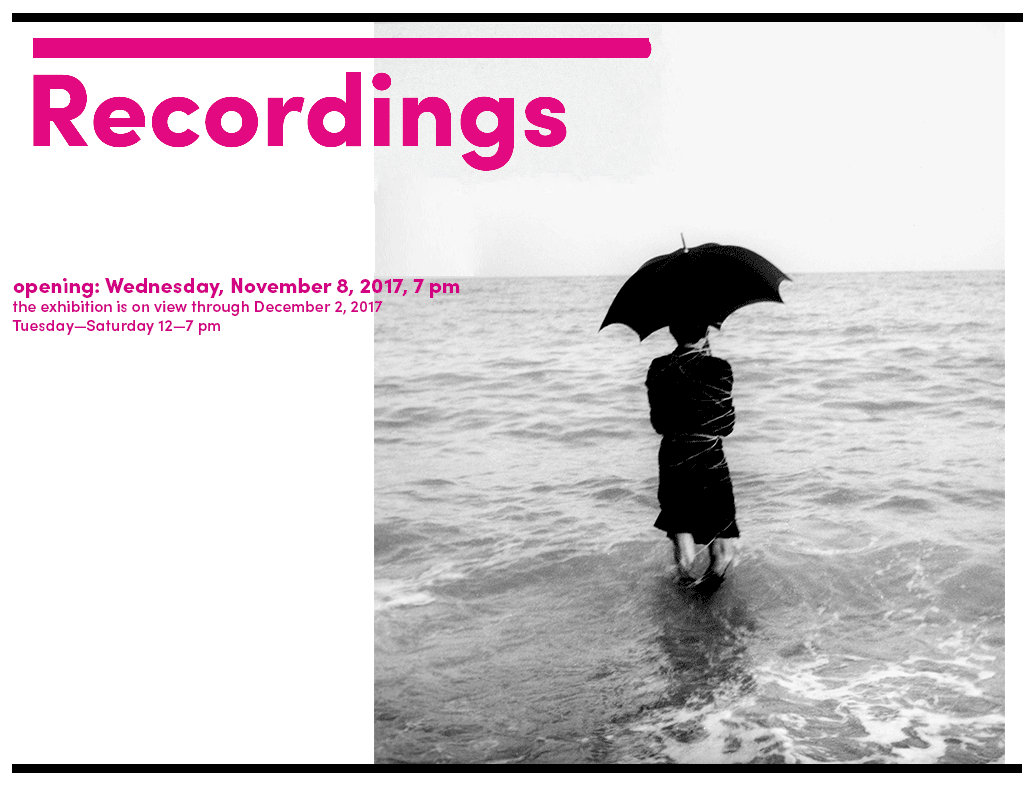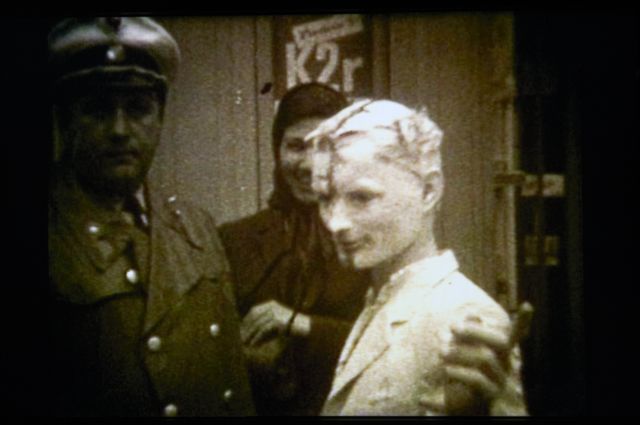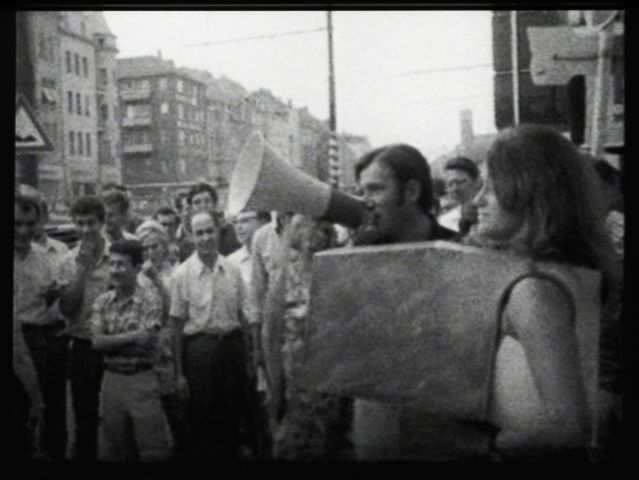
Openieng: Wednesday, November 8, 2017, 7 pm.
The exhibition: November 9 – December 2, 2017, Tuesday - Saturday, 12 – 7 pm.
Recordings is a three-year programme of film presentations that offer a glimpse into the works of the international art avant-garde. The idea of Recordings is to present to the public film registrations which transgress the category of “films about art” – live-recorded registrations of performances, happenings, concerts, street actions, and ephemeral pursuits from the borderline of the visual arts, theatre and music.
In the first edition of the programme, we present registrations of actions by avant-garde movements from Eastern and Western Europe during the 1960s and 1970s. Actions on the streets of Nice, Vienna and Ljubljana show the practices of radical artists, which functioned at the time on the margins of the official art circuit but are currently regarded as 20th-century classics. This edition of the programme also involves film recordings of the alternative music scene and artistic/social manifestations in 1980s Poland.
Film screenings will be accompanied by an exhibition dedicated to the presented recordings.
Programme of films presentations:
Ben Vautier, Les actions de rue, Nice, 1965–1982
November 8–10, 7 pm
introduction: Bożena Czubak, November 8, 7.30 pm
This French artist of Swiss origin, who has lived in Nice since 1949, is one of the leading names of the European mid-century avant-garde, and one of the best-recognised contemporary artists. Since the mid-1950s he has been using writing (écriture) in his work – from short sentences to extensive comments on art, culture, politics, power and the artist’s ego. He creates written images, covers various objects with writing, and includes writing in his installations. From 1958 to 1973 he ran a record shop in Nice known as Laboratoire 32, and later – “La galerie Ben doute de tout”, which during the 1960s was an alternative venue for exhibitions, meetings and discussions attended by the Nice school (César, Arman and Martial Raysse). Since 1959 he has published his own magazine, Ben Dieu.

In the 1960s he practiced the idea of appropriation – the provocative gesture of signing everything with his own name, including works by other artists; since the early part of that decade he has also been active as a performer. In 1962, in the window of One Gallery in London, he exhibited himself as a live sculpture. During the 1960s he was also one of the most active members of the Fluxus movement – thanks to his contribution Nice became one of the centres of this international association.
Street actions, presented as part of Recordings (Les actions de rue, Nice, 1965–1982) involved small actions in front of his shop, on the streets of Nice, in the port and on the beach; simple, non-pretentious, sometimes banal, often absurd activities such as eating at a table standing in the middle of the street or signing the horizon line. By his activities, often absorbing the attention of passers-by, the artist removed the border between art and life, situated the theatre of art inside daily life, and transferred the stage of the art gallery onto the streets.
The OHO Group
November 15–18, 7 pm
introduction: Dorotea Fotivec, November 15, 7 pm

The Slovenian group OHO was active between 1966 and 1971. Its members utilised various media – drawing, photography, concrete and visual poetry, film, video, happenings and street actions; they also published their own materials. Initially, they were focused on the notion of reism, and attempts at transgressing an anthropocentric vision of the world towards a hierarchy-free world of objects. By criticising the traditional division between art and life, members of the group wanted to locate their artistic practice within daily life. Abandoning the idea of the artist as a special creative personality, they offered for sale – often on the street – small objects such as matchboxes with a specially designed series of labels. In subsequent years, the group shifted their interests towards various formulas of the avant-garde of their time: conceptual art, body art, performance, land art, Arte Povera and experimental film. As part of Recordings we will show Naško Križnar’s film Triglav – the record of an action performed in Ljubljana in 1968. In Zvezda Park in the centre of the city, David Nez, Milenko Matanović and Drago Dellabernardina made a living sculpture consisting of their own bodies, designed as a New Year’s gift for the people of Ljubljana. In the title of the action and its triple-headed protagonist, they referred to the name of the highest mountain in Slovenia, the symbol of the country. Triglav, considered to be one of the iconic works of the Slovenian avant-garde, played ironically with methods of cultivating national pride. In 1971, members of the group abandoned participation in the art world in favour of living close to nature. They established a commune and settled in a village named Šempas, in the Vipava Valley in Slovenia.
The group was founded by Marko Pogačnik and Iztor Geister Plamen, followed by: Marjan Ciglič, Milenko Matanovic, Andraž Šalamun, Tomaž Šalamun, David Nez, Matjaž Hanžek, Naško Križnar, Vojin Kovač-Chubby, Aleš Kermavner and Franci Zagoričnik.
Józef Robakowski
Documentation from the Jarocin Festival of rock music in 1986 and the street actions of the Orange Alternative
November 22–25, 7 pm
introduction: Józef Robakowski, November 22, 7 pm

Józef Robakowski – pioneer of the neo-avant-garde in Poland, co-founder of the Workshop of the Film Form (1970–1977), a key formation for new media art. His innovative analyses of the structures of filmic language made in the 1970s are considered classics of structural cinema. In the 1980s, using video techniques, he pursued the idea of “one’s own cinema” – personal, often autobiographical records and registrations of performative actions. At the same time, he developed a critical thread regarding media policies and mechanisms of viewer manipulation by the ideologised mass media. Important parts of his practice are the video and film documentations about contemporary art and its avant-garde traditions. He is the creator of a vast collection of documentations, including film recordings of actions and performances by other artists. He was also a spokesman for the alternative music scene – he registered concerts, promo videos and photographic sessions for Moskwa, one of the most rebellious acts on the 1980s scene. As part of Recordings we will present his documentations from the Jarocin Festival of rock music in 1986. Robakowski was an active participant in the underground art scene during martial law in Poland, and in the late 1980s he documented the street actions of the Orange Alternative – an art/social movement which satirised the regime through subversive actions, highlighting the absurdity of the social and political reality of the late Polish People’s Republic era. The presented registrations include records of five Orange Alternative happenings in Łódź (1988–91).
Viennese Actionists and Valie Export
November 29–December 2, 7 pm
introduction: Stanisław Ruksza, November 29, 7 pm
The Viennese Actionists were one of the most radical art formations of the 1960s. Their actions were situated between the visual arts, theatre, para-religious rituals and political demonstrations. These proponents of direct art used the body as a basic medium and an object of art experimentation. The Actionists shocked with obscene behaviour and drastic measures such as self-harm, the killing of animals, masturbation and defecation. Their provocative actions were directed at the Catholic, bourgeois traditions of post-war Vienna. The transgression of boundaries, and liberation from social and sexual conventions had, in the Viennese Actionists’ practice, its basis in Freud’s theories about subliminal and repressed instincts.
Hermann Nitsch developed his idea of the Theatre of Orgies and Mysteries (Orgien Mysterien Theater), spectacles which connected the ecstatic and orgiastic with elements of sacrificial rituals and liturgical ceremonies, referring to themes of sexuality, violence and death. The Actionists broke all possible taboos: social, moral and religious. Their actions were considered highly controversial, which resulted in police interventions and a number of court cases. As part of Recordings, we will show e.g. Vienna Walk (1965) by Günter Brus, which ended in arrest for the artist, who was charged with breaching public order.

Valie Export (Waltraud Lehner) is an Austrian artist considered to be one of the leading figures of feminist art. She is the author of Women’s Art: A Manifesto (1972), who advocated the seizure of the means of art production by women and dealt radically with themes related to the body and gender. The artist, active since the mid-1960s, began in 1967 to use a pseudonym borrowed from the name of a brand of cigarettes popular in Austria at the time (Smart Export). Due to the use of her own body, and the auto-aggressive activity in her works (along with the subversive nature of her actions), Export has often been linked to the Viennese Actionists. The basic themes of her art refer to the influence of the media on shaping the image and role of women in the world. The artist often subverts the stereotypical patterns of male-female relationships. Many of her actions took place in public space. As part of Recordings, we will see e.g. the record of the artist’s well-known action TAP and TOUCH CINEMA (TAPP und TASTKINO) from 1968. The creator walked through the streets with a box attached to her torso, covering her naked breasts but with two holes cut out at their level. She encouraged passers-by to put their hands inside and touch her body directly.

